Sifting the Ashes of Counterinsurgency: The Role of America’s Phoenix Program in the Vietnam War
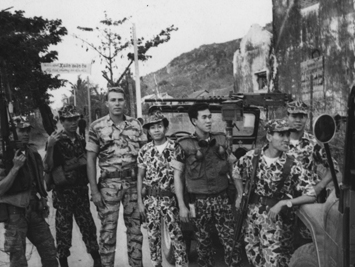
Fifty years ago the North Vietnamese launched the Tet Offensive, a multi-pronged military campaign that underscored South Vietnamese President Nguyen Van Thieu’s inability to protect his country’s urban areas from attack.
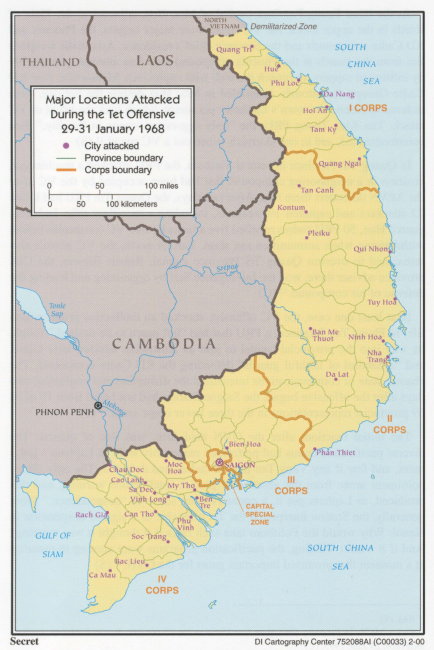
Although the assaults were eventually repulsed, the heightened focus on the defense of South Vietnamese cities exposed rural areas to greater infiltration by the National Liberation Front (Viet Cong) cadre, consisting of civilians and paramilitary personnel collaborating with the communist North.
America formalized the Phoenix Program in 1967 as a means of addressing just this eventuality. Through a melding of rural development with intelligence gathering and targeted detention and killing of suspected Viet Cong, they hoped to turn the tide of the war to the South and democracy.
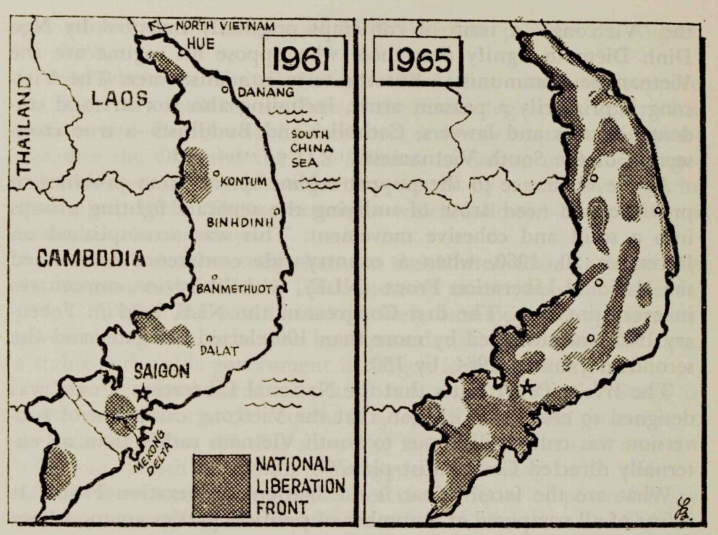
The South Vietnamese government was already pursuing a similar counterinsurgency program called Phuong Hoang, named for the immortal bird of Vietnamese and Chinese mythology which those in the West would recognize as a phoenix. It seemed reasonable for both countries to leverage these native efforts with American military and analytical support to achieve what was broadly construed as the “pacification” of insurgent elements in the countryside.

The U.S. Central Intelligence Agency coordinated the Phoenix Program in an advisory role with American and allied special forces, and with South Vietnamese internal security units which would carry out the actual operations. The program lasted from approximately 1967 to 1972, during which time it came under intense congressional and media scrutiny. Lax oversight by the CIA led to extrajudicial detention, torture and killings of purported Viet Cong “infrastructure,”which in this context refers to communist political activists.
Foreign Broadcast Information Service (FBIS) Daily Reports, 1941-1996, are a rich source for foreign coverage of the Phoenix Program, complemented by Joint Publications Research Service (JPRS) Reports, 1957-1994. For the American audience The Washington Evening Star published numerous stories on the Phoenix Program as its methodology and effectiveness were examined on Capitol Hill. The official, unclassified records of those investigations can be found in the U.S. Congressional Serial Set, 1817-1994, which features in-depth accounts of the program’s goals, operations, achievements and shortcomings.
In September 1968 before it became controversial, “Operation Phoenix” was lauded in an editorial by The Evening Star:
In theory, the operatives of the three Vietnamese intelligence services, the Police Special Branch, the Defense Department, and the Army, are working in tandem out of District Intelligence and Operations Centers in about 200 key districts. Supposedly inter-service rivalries are being laid aside, political intrigues abandoned, and intelligence information shared. United States intelligence reportedly has been playing a prominent advisory role.
It is claimed that 6,000 members of the shadow government have been captured or killed, but this leaves thousands of Viet Cong officials burrowed in. Operation Phoenix, like all intelligence operations, is a dirty business, but it is a necessary one, never more than now. It should not be permitted to fail.

Intelligence could come into the Phoenix Program in numerous ways: from Vietnamese police or rural development teams; from paid informants or defectors; from persons detained during operations. Procedural safeguards were said to guarantee due process. There were several levels of potential complicity for suspected Viet Cong, and three witnesses were technically required to justify detention. A computerized database kept track of all of the details. What could possibly go wrong? As it turns out, rather a lot.
Once a suspect was targeted, they would be arrested by Provincial Reconnaissance Units (PRUs), interrogated and kept in detention for up to two years without trial. Those detained were frequently subjected to torture and eventually died in custody. Those who resisted arrest or who were otherwise notorious were often “neutralized,” which is to say, killed outright.
As the program evolved the CIA minimized the use of such terms as “blacklist” and “elimination,” but the actual operations continued as before. As the editorial above says, Operation Phoenix was “a dirty business.” For all its brutality, a little over a year following the editorial above, the Star reported that Phoenix may not have been especially effective:
The most bitter disappointment—and the sharpest sign of latent enemy strength—has been the lack of success of the “Phoenix” program, an effort at coordinating all intelligence activities on both the provincial and district levels.
Americans claim the program has “neutralized”—killed, captured, or persuaded to defect—some 16,000 enemy agents.
But intelligence analysts doubt if the program has substantially damaged the top of the VC “infrastructure” on which the enemy bases its efforts. They estimate the manpower of this “infrastructure” at approximately 75,000.

Even the successes of the Phoenix Program were difficult to quantify. The information obtained was often impossible to verify, and a high level of subjectivity was required of those receiving it: a source could be settling personal scores, responding to bribery or corruption, acting as a provocateur, inflating evidence for financial gain, or simply fabricating it to avoid detention or torture. It’s clear from the press coverage and official U.S. Congressional testimony that all of these factors were present, even endemic, to the program.
Seizing an opportunity to compare the actions of the United States to those of Nazi Germany, the Soviet Union took early note of perceived excesses of Phoenix, as seen in this FBIS Daily Report for December 3, 1968:
The American papers report that the top experts on Vietnam took part in drawing up this plan, known as Phoenix. It provides for the pacification of the main regions of South Vietnam, that is, the return to the control of the Saigon puppets of a considerable area by means of sword and fire. The United States made available its crack units, to implement the Phoenix plan, as well as the Saigon puppet regime’s [as heard] which were equipped with the newest weapons.
Practically all the heavy B-52 bombers based on Guam Island and Thailand have been put at the disposal of the leaders of Operation Phoenix. The first reports about the implementation of this operation reveal that it is based on scorched-earth tactics—used by the Nazi invaders in the Second World War.

Although a number of U.S. servicemen would level similar charges, it bears mention that the Phoenix Program was intended to be limited in its operations; it targeted individuals or small groups rather than undertaking the annihilation of entire villages. Nonetheless, it did facilitate the systematic apprehension and killing of civilians, which could account for accusations of its involvement in the killing of more than 500 civilians during the 1968 My Lai Massacre, as seen below in the Evening Star:
Operation Phoenix, a major counter-insurgency program being conducted jointly in Vietnam by the Central Intelligence Agency and the Defense Department, has been swept into the growing controversy stemming from the alleged My Lai massacre.
Col. Marshall Fallwell, commandant of the Army’s Intelligence School, held a rare press conference here today to deny a persistent rumor that his instructors teach terror tactics and assassination techniques to Vietnam-bound intelligence officers.
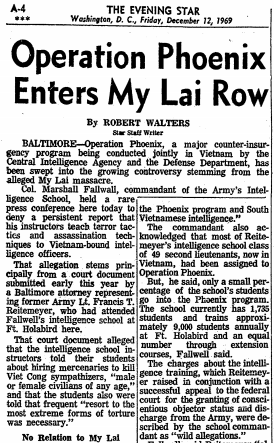
With accusations by American servicemen under oath of links between the Phoenix Program and the My Lai Massacre, there was soon talk of a congressional investigation, as seen in this report from TASS found in FBIS Daily Reports:
Senator William Fulbright said that at the end of February the Senate Foreign Relations Committee, headed by him, would start investigations into the “program of mass extermination” in South Vietnam carried out by American Special Forces in accordance with the so-called “Operation Phoenix.”
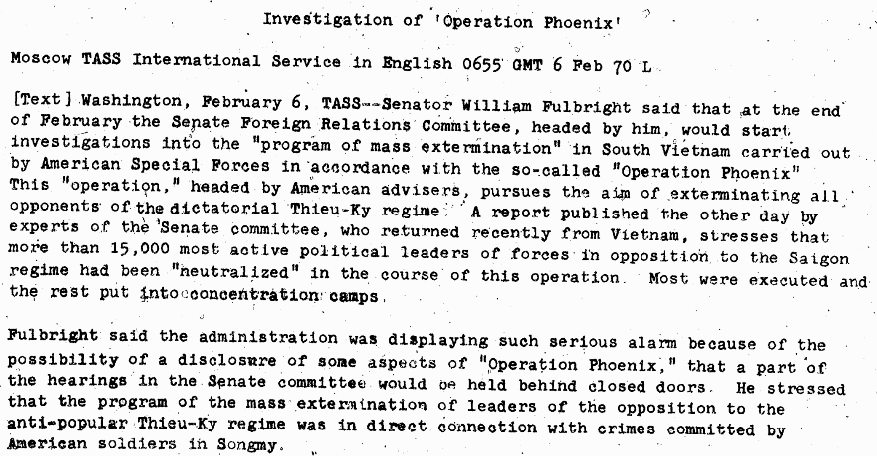
Fulbright is quoted above as saying that Phoenix would be discussed “behind closed doors,” but the U.S. House Committee on Government Operations would not be so reticent in entering the transgressions of Phoenix into the public record. As Pulitzer Prize-winning staff columnist for the Evening Star Mary McGrory wrote, Phoenix was “a grisly operation that the House subcommittee on Foreign Government Operations is desperately trying to uncover and stop.”
She had no need for harsh words of her own; the title of her Star column in which Phoenix is cast as “sterile, depersonalized murder” was drawn from a direct quotation of K. Barton Osborn, a former American intelligence officer.
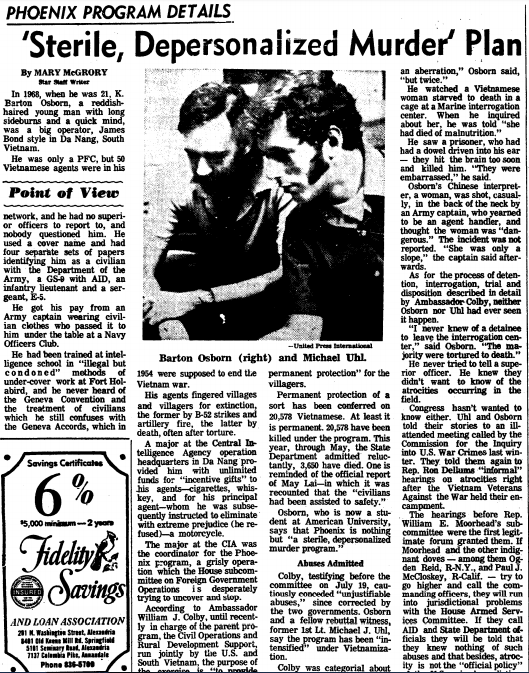
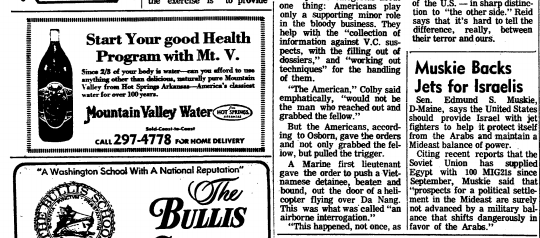
The official U.S. deferral of criticism of the Phoenix Program fell into patterns: the abuses cited were held to be aberrations to standard discipline, framed as incidental in extenuating circumstances, and/or attributed to persons other than American citizens.
Such plausible deniability was undercut by testimony that far from being exceptional, assassination and terror were taught in the standard curriculum at the Army Intelligence School at Fort Holabird in Baltimore, Maryland. In the following Evening Star account, Phoenix training took place at Fort Howard, Maryland, on the grounds of a nearby Veterans Administration hospital which included a mock Vietnamese village known as Fort Du Duc Huc. Here’s the Intelligence School’s Col. Fallwell again:
Although only “a small percentage” of the 9,000 students who graduate annually from the Ft. Holabird intelligence school go into Operation Phoenix, “almost the entire class (of 49 second lieutenants) that [Francis T.] Reitemeyer was in was going into the Phoenix program,” [Col. Marshall] Fallwell said. And, all the students taking the six-week course in which Reitemeyer participated are given “three hours of instruction on the Phoenix program” as well as field training at Ft. Howard, the commandant said.
Although Reitemeyer “alleged that he had been taught terror tactics and that he had been taught to assassinate people,” an “informal review” produced the conclusion that “it just isn’t done,” Fallwell said.
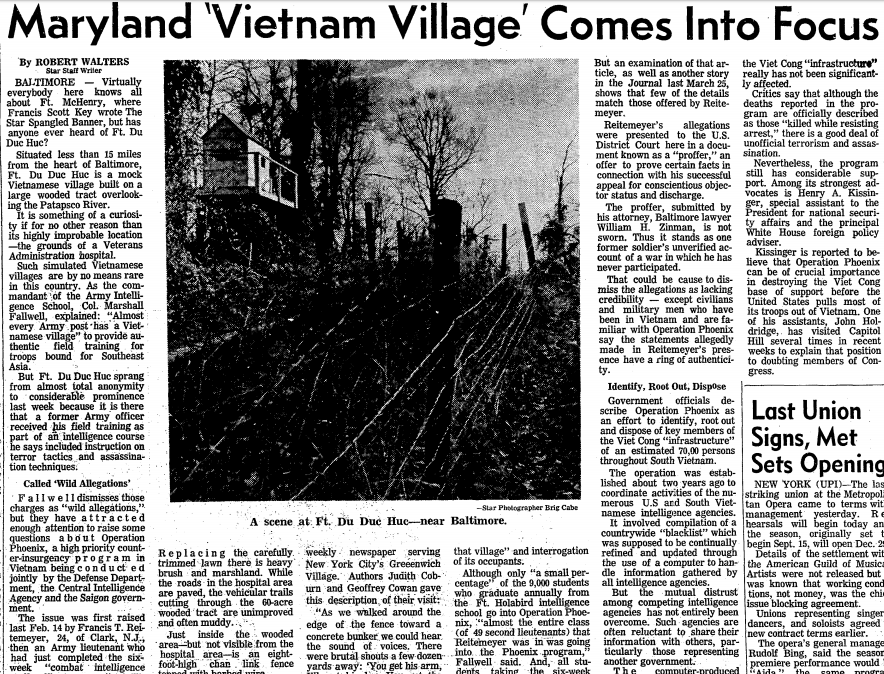
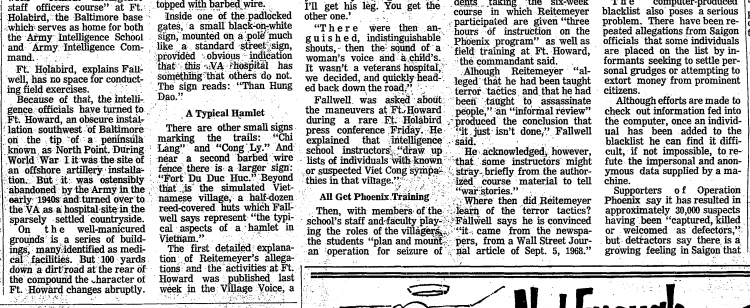
Ambassador and late Director of Civil Operations and Rural Development (CORDS) in Vietnam William E. Colby held that Phoenix was worthwhile despite “some unjustifiable abuses”:
In defending against the Viet Cong, he said, there have been “some unjustifiable abuses” in the past, but U.S. and Vietnamese governments “have worked to stop them, and produce instead professional and intelligent operations which will meet the Viet Cong infrastructure attack with stern justice, with equal stress on both words.”

In 1972 Madame Nguyen Thi Binh, Foreign Minister of the Provisional Revolutionary Government of the Republic of South Vietnam, downplayed the significance of the Phoenix Program. Representing the Viet Cong during an interview broadcast on the Voice of the GDR [German Democratic Republic] Domestic Service, which can be found in FBIS Daily Reports, Madame Binh was asked:
[Question] This concept of Vietnamization includes the so-called Phoenix program which Saigon and Washington (?cynically) describe as a pacification program. What are the results of this program?
[Answer] Like the other so-called pacification plans which the United States invented together with the puppets, the Phoenix program is criminal and murderous. They are plans of barbarous blackmail to force the people into the so-called strategic hamlets. All these plans are calculated to liquidate the liberation forces and to gain control over the people. At present the pacification program is rapidly being eroded by the popular uprisings in all South Vietnamese provinces.

An earlier, more colorful description of the travails of “pacification” appears in the pages of Lao Dong [Labor] directly from Hanoi, courtesy of Joint Publications Research Service (JPRS) Reports, 1957-1994:
To simplify fooling public opinion even more, the Thieu-Ky-Huong gang has made up another thing called “operation phoenix,” a “general pacification in the countryside.”
Why has the U.S. aggressor and the clique of Vietnamese traitors, Thieu-Ky-Huong regurgitated these “accelerated pacification plans” and widely advertized them? Everyone knows that through the process of general offensives and uprisings since the beginning of spring and close association with forceful military attacks, the army and people of South Vietnam uniformly rose up to destroy enemy oppression, destroy many strategic hamlets, and liberate many areas of the vast countryside. In nearly all localities they have established revolutionary governments in the elements; and in some places they have completely organized revolutionary governments at district and provincial levels.
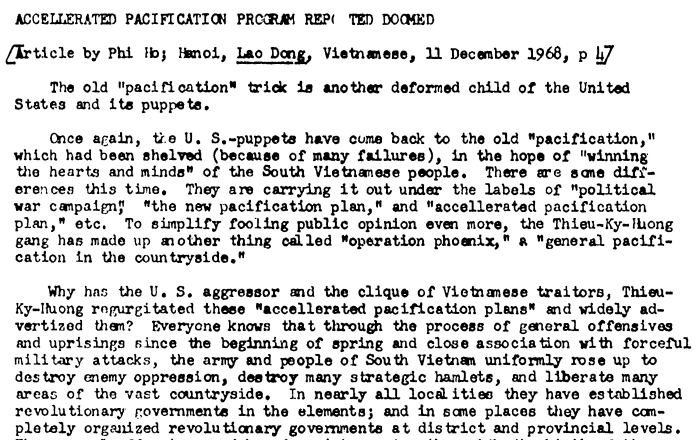
From the Viet Cong’s perspective then Phoenix was variously “murderous” and bound to fail, but hardly the game-changer it was made out to be. Even allowing for the propaganda content of such assertions, the terms of America’s ultimate withdrawal from the conflict do seem to support those conclusions.
On this side of the Pacific, Americans were getting mixed messages about the impact of Phoenix: maybe the Viet Cong were on the ropes because of their losses during the Tet Offensive; maybe the suspension of Operation Rolling Thunder allowed less experienced cadre to join the fray. Or maybe Phoenix was depleting the ranks after all—as suggested in this Evening Star reporting.
...the 13-month-old, Saigon-run Operation Phoenix, which has been attacked by Hanoi Radio almost daily in recent days, has seriously damaged the Viet Cong’s village infrastructure. Phoenix is claimed to have killed or captured more than 15,000 of the 80,000 Viet Cong political agents thought to be in the South.

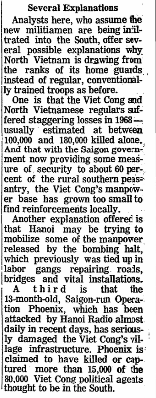
Can a U.S. House of Representatives subcommittee get to the bottom of things? In this case the Russians thought so—as reported by TASS and found in FBIS Daily Reports:
The House of Representatives subcommittee for foreign operations and government information has published a special report announcing that U.S. soldiers participated directly in the implementation of the “Phoenix” program undertaken by the Saigon regime for the purpose of the physical liquidation of all opposition to “President” Thieu.
Quoting the evidence given by the participants of the “operation” and the results of the investigation carried out by the Congress in South Vietnam, the authors of the report state that “U.S. soldiers acting without trial or investigation subjected South Vietnamese to torture, shot them and dropped them from helicopters.” They admit that in the course of the operation over 20,000 innocent civilians were shot dead.
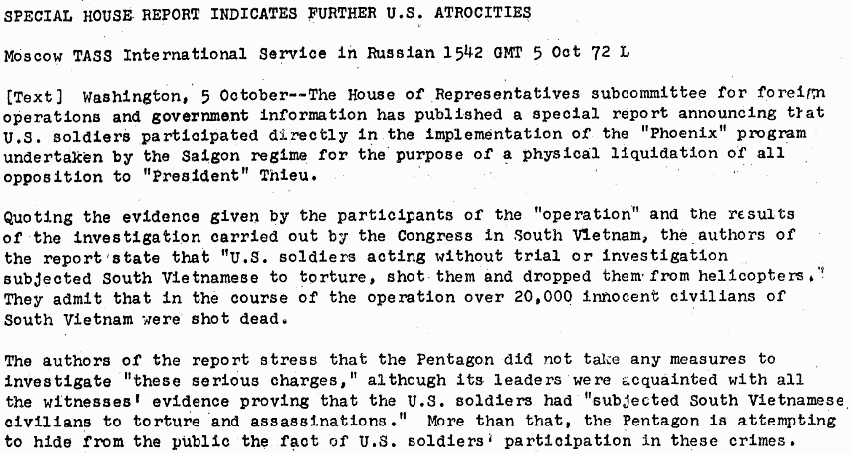
Rather than take TASS at its word, it’s worthwhile to go directly to the U.S. Congressional Serial Set, 1817-1994 for the source of these assertions. The following material is all drawn from the publication "U.S. assistance programs in Vietnam. Twenty-second report by the Committee on Government Operations... October 17, 1972."
Bearing in mind that verification on either side is challenging, the statistics show 20,587 purported Viet Cong cadre killed, while 14,518 persons died from causes attributed to Viet Cong terrorism.
First, the effect of Viet Cong terrorism:

And Phoenix success rates against the Viet Cong:

And now for the testimony—found in the U.S. Congressional Serial Set—of Ambassador William E. Colby, formerly head of Civil Operations and Rural Development Support (CORDS), in charge of all aspects of pacification in South Vietnam from February 1969-June 1971, at which point he transitioned to serve as the Director of the Central Intelligence Agency:
Mr. [Ogden] Reid. *** (Your) testimony before the Senate is replete with some indications and some explicit reports that at times the district coordinating center or the senior advisors have admitted they have made mistakes or are not certain of their information.
My question is: Are you certain that we know a member of the Vietcong Infrastructure from a loyal member of the South Vietnam citizenry?
Ambassador Colby. No; Mr. Congressman, I am not.
Mr. Reid. The answer to that seems to be no, at least in some cases. Therefore there is the possibility that someone will be captured, sentenced, or killed, who has been improperly placed on a list without adequate verification. If it is inadequate, my question goes back to the first point: Isn’t that a reason for making sure that legal proceedings are totally fair?
Ambassador Colby. I certainly would like to see them improved and we have been working to see them improved. I think they are considerably improved. As I said, I do not think they meet the standards I would like to see applied to Americans today.
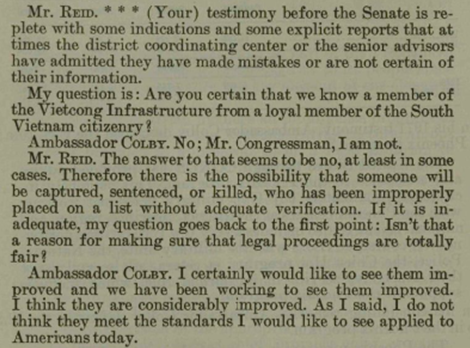
Representative Reid was not alone in his misgivings:
Mr. [William S.] Moorhead. The thing that concerns me is that the Phoenix Program imposes monthly quotas. I am sure this may eliminate some hard-core Communists, but may it not include the “neutralization” of innocent persons because they refuse to come up with the requested bribe?
Ambassador Colby. I would say the answer is that it is possible that they be arrested or threatened with arrest unless they pay a bribe. That is a complaint that has been made in the legislature and in the press in Vietnam against individual police or military officials or local officials. That kind of complaint has been made.
I, frankly, think that the procedures that we have gotten prevent very much of that going on to full conviction. I am convinced also that it does not result in their being killed because the kill situation comes from fire fight, and a fighting situation. That is why people get killed. They do not go out to kill them.
Mr. Moorhead. But they can be arrested and brought up before—
Ambassador Colby. But they can be arrested and the bribery and corruption problem can exist.
Mr. Moorhead. They can be brought before a tribunal of questionable officers.
Ambassador Colby. The actions include such things as requiring that the village chief be informed of operations, of arrests taking place within his village, so that he can reflect the local community attitude toward that individual.
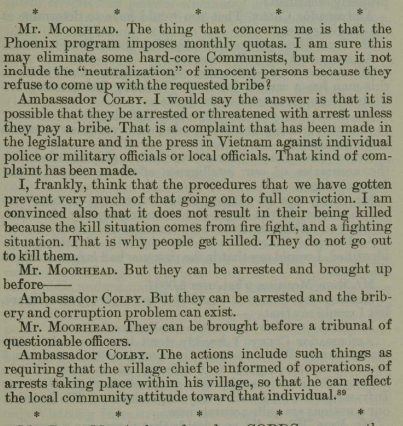
But Representative Reid was not done with Ambassador Colby:
Mr. Reid. Of the listings you have had for about a year, what degree of accuracy did you find?
Did you find that the people that had been listed by the Phoenix program were in fact Vietcong Infrastructure, or a large percentage thereof, or did you find that some were not properly identified?
Ambassador Colby. That you would have to determine at the district center.
Mr. Reid. Have you verified anything at the district center?
Ambassador Colby. We have.
The existence of intelligence reports which would indicate this man has a certain job in the Vietcong Infrastructure—the intelligence report is in the dossier.
Mr. Reid. Can you say that there is a high degree of accuracy in the initial dossier or report or do you have some concern as to the accuracy?
Ambassador Colby. I have never been highly satisfied with the accuracies of our intelligence effort on the Vietcong Infrastructure.
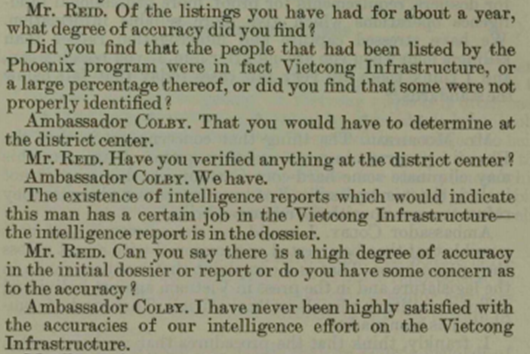
Then there is the gritty testimony of the men on the ground such as Michael Uhl, a former U.S. military intelligence officer. In the passage preceding that quoted below the term “CD’s” refers to “civil defendants.”
Mr. Colby, in response to a direct question, denied that Americans actually exercised power of arrest over Vietnamese civilians. In Duc Pho, where the 11th Brigade base camp was located, we could arrest and detain at will any Vietnamese civilians we desired, without so much as a whisper of coordination with Army of the Republic of Vietnam or Government of Vietnam authorities. But the impact of this oversight in Ambassador Colby’s testimony pales when compared to his general lack of understanding of what is actually going on in the field.
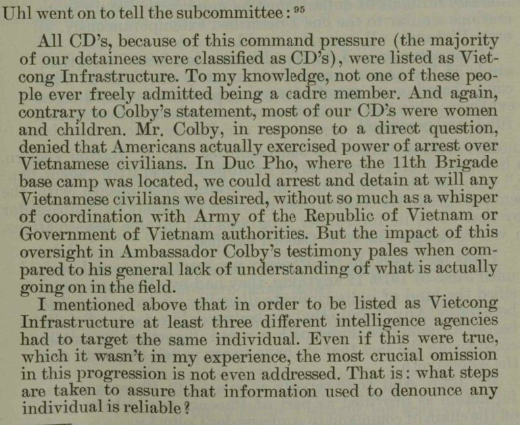
Uhl continues:
The first MIT [military intelligence team] employed 11 coded sources. These were indigenous subagents paid to provide us with “hot intel” on the Vietcong personalities and movement in our AR [area of operation]. We had no way of determining the background of these sources, nor their motivation for providing American units with information. No American in the team spoke or understood Vietnamese well enough to independently debrief any “contact.” None of us were sufficiently sensitive to nor knowledgeable of the law, the culture, the customs, the history, et cetera.
Our paid sources could easily have been either provocateurs or opportunists with a score to settle. Every information report (IR) we wrote based on our sources’ information was classified as (1) unverifiable and (2) usually reliable source. As to the first, it speaks for itself; the second, in most cases was pure rationale for the existence of the program.
The unverified and in fact unverifiable information, nevertheless, was used regularly as input to artillery strikes, harassment and interdiction fire (H&I), B-52 and other air strikes, often on populated areas. We churned out a dozen IR’s per week, not because it was good or reliable information, but it was our mission. Furthermore, it was not possible, given the conditions in Vietnam, for a tactical unit to produce reliable and verified intelligence data.
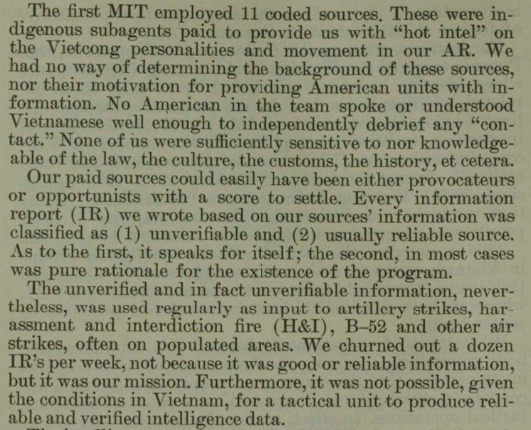
Where Uhl’s testimony told of attacks on populations by artillery and aircraft, that of K. Barton Osborn, another U.S. intelligence agent, detailed the abuse of individuals:
Mr. Reid. When you say “wholesale” I take it you mean during your period there was sufficient assassination so it could be described as immediate neutralization, which was another phrase you used, or assassination on the spot, frequently with no evidence beyond fragmentary rumors, if that, and in some cases after the fact identifications were made on allegedly the CI [communist infrastructure], who may not have been the CI at all?
Mr. Osborn. In fact, the intelligence reports we got as summaries were the reports of that kind of standard operating procedures and the provisional reconnaissance units which I described earlier which the CIA called goon squads, unofficially had the primary mission of the assassinations which were euphemized by Ambassador Colby and others as neutralization; yes.
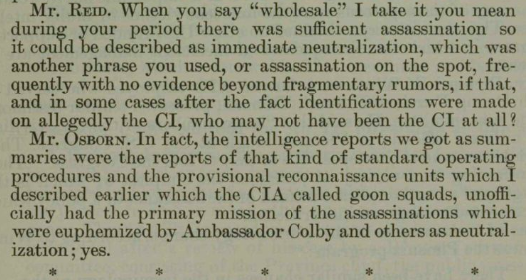
[Mr. Reid.]...Do you have any knowledge of the inventory and prior to your departure from Vietnam were there anything representing accurate reports as to where the Vietcong Infrastructure detainees or insurgents are being held?
Mr. Osborn. No; as I said before, I never knew in the course of all those operations any detainee to live through his interrogation. They all died.
Mr. Reid. They all died?
Mr. Osborn. They all died. There was never any reasonable establishment of the fact that any one of those individuals was, in fact, cooperating with the Vietcong, but they all died and the majority were either tortured to death or things like thrown from helicopters.
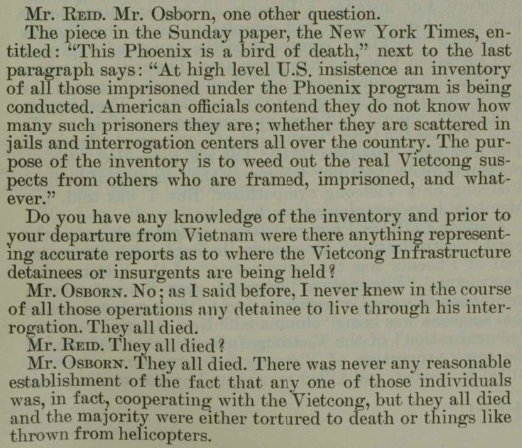
Unfortunately, Osborn gets more specific:
They antagonized him several times by taking him with his elbows behind his back, hands tied, running him up to the door of the helicopter and saying, “If you don’t tell us what we need to know we are going to throw you out of the helicopter.” They did this two or three times and he refused to say anything. He couldn’t respond. He wouldn’t respond. Therefore, on the fourth trip to the door they did throw him out from the helicopter to the ground.
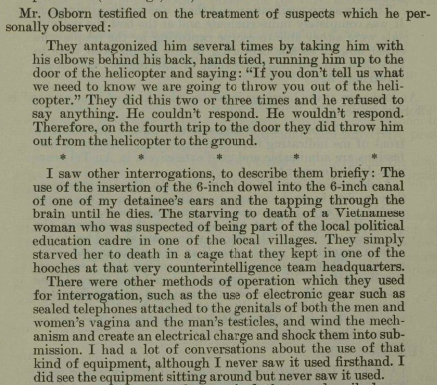
The reader can continue on in the passage to discover the effects of wooden dowels and cages and electricity on the human body and spirit. With such graphic testimony, Representatives Conyers and Abzug came to a damning conclusion:
[quoting Colby] The Phoenix program of the Government of South Vietnam is designed to protect the Vietnamese people from terrorism and political, paramilitary, economic, and subversive pressure from the Communist clandestine organization in South Vietnam. (Report, 44.)
Apparently the Ambassador is misinformed, for, rather than protecting the Vietnamese people, the Phoenix program subjects them to terrorism and political, paramilitary, economic, and subversive pressure from Thieu’s repressive regime.

According to official figures the number of people affected by these programs in 1970 was 6,405 sentenced, 7,745 rallied and 8,191 killed. To be “rallied” is to become a pro-Thieu terrorist. (Hearings, 183.)
The committee notes that, according to official figures furnished by Ambassador Colby, a total of 20,587 suspected VCI were killed from the beginning of 1968 through May 1971. It is impossible not to wonder how many of those persons were the innocent victims of faulty intelligence. The committee can think of no other U.S.-funded or supported program in which the consequences of inefficient management are so extreme. (Report, 54.)

Representative Ogden Reid of New York gave an especially caustic evaluation of the Phoenix Program:
This program is without parallel in U.S. history. I have long felt that we should never have had anything whatsoever to do with it and the sooner we stop it completely and insist that the South Vietnamese stop it dead in its tracks and anything to do with it, the better; that it is a total and clear violation of the Geneva Convention. It places our officers and men in totally impossible situations and it is precisely the kind of thing the United States is opposed to.
Here we are participating in it or directing it, as the case may be. *** I do not see how this committee can, with any kind of conscience at all permit this to continue. (Hearings, p. 338)
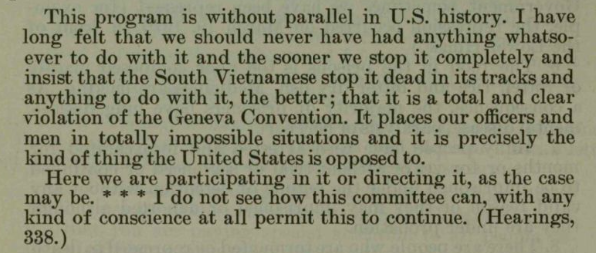
The 1973 report entitled, Activities of the House Committee on Government Operations summarizes that committee’s findings in the following words:
The report concluded that the $5 billion pacification (CORDS) program has been marked with inadequate fiscal controls, poor management of funds, spotty recordkeeping, and some highly questionable program objectives. Such matters were raised both during the subcommittee’s hearings and by a GAO report based on an investigation of the program conducted at the subcommittee’s request. Also a matter of concern were the conclusions about the Phoenix program’s intelligence gathering procedures, its imprecise methods of “targeting” suspected Vietcong for “neutralization,” its lack of adequate legal and detention procedures, and serious moral considerations of U.S. support for such a program that has allegedly included murder, torture, and inhumane treatment of South Vietnamese civilians.
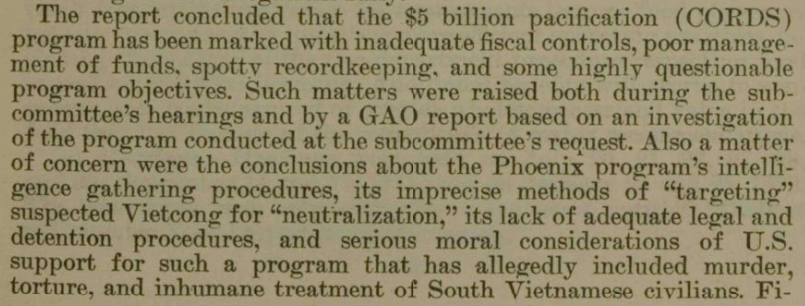
So with its “wholesale” assassination program and possible complicity in the My Lai Massacre, did the Phoenix Program fit the definition of genocide? The admittedly leftist International Commission of Inquiry into U.S. Crimes in Indochina, meeting in Copenhagen in 1972, thought that it did, as reported from Hanoi and found in FBIS Daily Reports:
Opposition of any kind be it Catholic or Buddhist, liberal or neutralist, especially among the young, is crushed through arrests, torture and assassination. From January 1969 to summer 1972, 40,000 civilians in South Vietnam were executed without trial under the Phoenix program. At least 200,000 political prisoners are kept incarcerated, including many persons prominent in the third force, whom Thieu has threatened with extermination for this very reason.

In 1982 Moscow was still raking these coals, as seen in this coverage by TASS from FBIS Daily Reports:
Units of the U.S. military intelligence took an active part in the “Phoenix” operation. But the leading role was played by the CIA. It is known, for instance, that Colby himself set monthly quotas for the destruction of civilian population and they had to be met.
Brutal torture and mass murder are only one outward aspect of the CIA’s criminal activity in Vietnam. There are many proofs that the Central Intelligence Agency originated the U.S. Vietnam venture by creating on purpose the situation which prompted the U.S. congressmen’s decision on armed intervention in Vietnam.
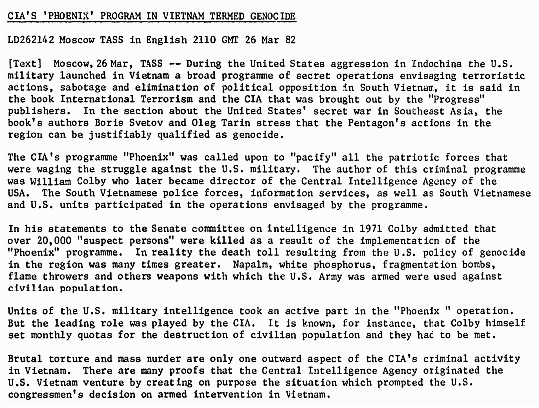
So were there lessons learned by the turmoil and bloodshed created by the Phoenix Program in South Vietnam? Apparently the conclusion drawn was to use a similar approach to pacification in other contexts, such as in the Philippines in the mid-1980s:
Ralph McGehee, a member of the mission who previously served the CIA for 25 years, told a press conference there were “direct parallels” between the counterinsurgency operations involving vigilante groups which are being launched by the military in the country and those conducted by the U.S. during the Vietnam War.
Vigilante groups, such has the Alsa Masa (People’s Uprising) and the Nakasaka (People United for Peace), he said, had a counterpart in Vietnam called “provincial reconnaissance units” which were actually “assassination teams” sent to “purify villages” of alleged communists.
The direct parallels, he added, can be seen in the way the military and vigilante groups have launched “search-and-destroy operations,” created “free-fire zones” and forced people from rural areas to population centers to deny the insurgents a recruiting base.
McGehee also said there was a high possibility that the CIA’s Phoenix Program, a coordinated military, police and civilian effort to destroy Vietnamese revolutionary forces and which made use of assassination squads trained by special forces working with the CIA, is already being employed in the country.
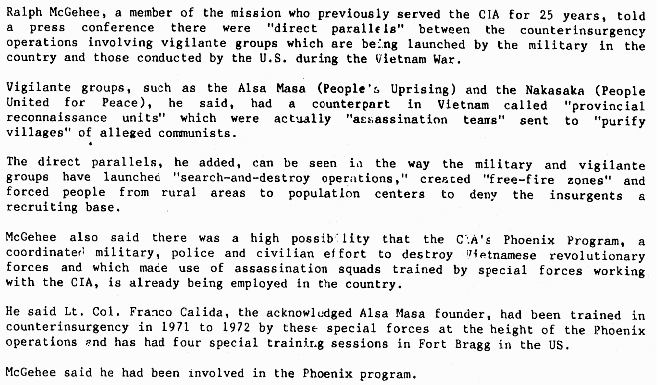
Finally, what became of the indigenous Phoenix operatives once the U.S. pulled out of Vietnam? JPRS Reports describe their fate in at least one locale:
At Tuy Hoa, a locality of 10,000 inhabitants north of Nha Trang, policemen who had participated in Operation Phoenix (designed to destroy the infrastructure of the NFLSV (National Front for the Liberation of South Vietnam) were reportedly massacred by relatives of their own victims.

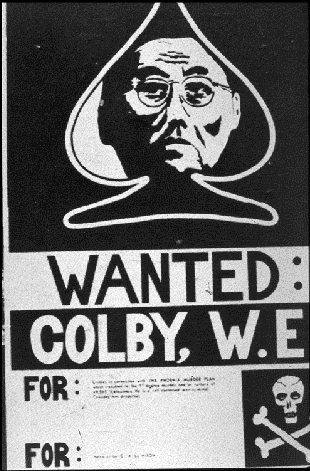
For more information about the Evening Star, 1852-1981; U.S. Congressional Serial Set, 1817-1994, Joint Publications Research Service (JPRS) Reports, 1957-1994, or Foreign Broadcast Information Service (FBIS) Daily Reports, 1941-1996, please contact readexmarketing@readex.com.




